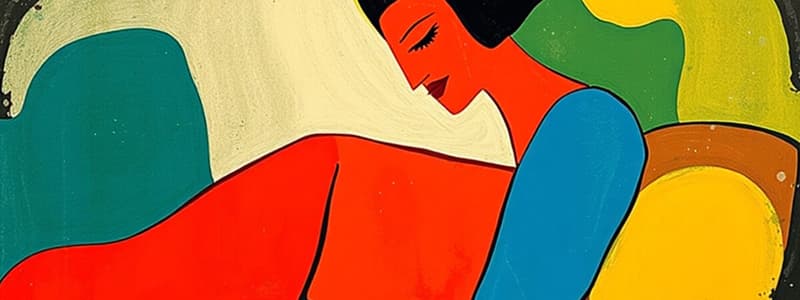Podcast
Questions and Answers
How did Southern Renaissance writers distinguish themselves from earlier "Lost Cause" literature?
How did Southern Renaissance writers distinguish themselves from earlier "Lost Cause" literature?
They brought a new critical appreciation to the region's burdens of history, racism, and conservatism, moving away from glorifying the antebellum South.
What themes did later Southern Renaissance writers explore in their works?
What themes did later Southern Renaissance writers explore in their works?
They tracked the changes reshaping the postwar South, addressing issues like evolving social structures and cultural shifts.
What earlier movement did Black authors build on in midcentury literary circles?
What earlier movement did Black authors build on in midcentury literary circles?
Harlem Renaissance
Who wrote Native Son, a chilling portrait of a black Chicago killer?
Who wrote Native Son, a chilling portrait of a black Chicago killer?
Which Southern author received the Nobel Prize in 1950?
Which Southern author received the Nobel Prize in 1950?
What is the name given to writers who brought a critical appreciation to the South's burdens of history and racism?
What is the name given to writers who brought a critical appreciation to the South's burdens of history and racism?
Who wrote The Confessions of Nat Turner, a controversial fictional representation of an 1831 slave rebellion?
Who wrote The Confessions of Nat Turner, a controversial fictional representation of an 1831 slave rebellion?
Name any one of the three Jewish novelists mentioned in the text.
Name any one of the three Jewish novelists mentioned in the text.
How did Robert F. Kennedy's goals for the FBI differ from J. Edgar Hoover's priorities, and what does this reveal about the changing focus of the era?
How did Robert F. Kennedy's goals for the FBI differ from J. Edgar Hoover's priorities, and what does this reveal about the changing focus of the era?
In what ways did Kennedy's administration represent a shift in American politics and culture?
In what ways did Kennedy's administration represent a shift in American politics and culture?
What was the name given to Kennedy's vision for America's potential?
What was the name given to Kennedy's vision for America's potential?
Which position did Robert F. Kennedy hold in his brother's cabinet?
Which position did Robert F. Kennedy hold in his brother's cabinet?
What was the name of the organization that Kennedy created to send young volunteers to underdeveloped countries?
What was the name of the organization that Kennedy created to send young volunteers to underdeveloped countries?
What was Robert McNamara's position in Kennedy's cabinet?
What was Robert McNamara's position in Kennedy's cabinet?
What issue was Bobby Kennedy trying to address by recasting the priorities of the FBI?
What issue was Bobby Kennedy trying to address by recasting the priorities of the FBI?
What type of bill did the legislative branch vote down in 1963?
What type of bill did the legislative branch vote down in 1963?
What was the all-important House committee that was dominated by conservatives?
What was the all-important House committee that was dominated by conservatives?
Explain how the construction of the Berlin Wall affected the relationship between the United States and the Soviet Union.
Explain how the construction of the Berlin Wall affected the relationship between the United States and the Soviet Union.
How did Kennedy's 'flexible response' strategy differ from Dulles's 'massive retaliation' doctrine, and what were the potential drawbacks of 'flexible response'?
How did Kennedy's 'flexible response' strategy differ from Dulles's 'massive retaliation' doctrine, and what were the potential drawbacks of 'flexible response'?
Describe the Trade Expansion Act of 1962 and its broader impact on international trade.
Describe the Trade Expansion Act of 1962 and its broader impact on international trade.
Explain how the policy of supporting Ngo Dinh Diem in South Vietnam ultimately backfired on the Kennedy administration.
Explain how the policy of supporting Ngo Dinh Diem in South Vietnam ultimately backfired on the Kennedy administration.
What did Kennedy secure passage of in 1962 to promote trade with EEC countries?
What did Kennedy secure passage of in 1962 to promote trade with EEC countries?
What word was coined to describe the invigorated international commerce?
What word was coined to describe the invigorated international commerce?
What strategy did Kennedy push as an alternative to 'massive retaliation'?
What strategy did Kennedy push as an alternative to 'massive retaliation'?
What military group did Kennedy bolster, specializing in anti-guerilla fighting?
What military group did Kennedy bolster, specializing in anti-guerilla fighting?
In what country did Kennedy sharply increase the number of 'military advisers'?
In what country did Kennedy sharply increase the number of 'military advisers'?
What was the name given to the post-WWII European free-trade area that was encouraged by the US?
What was the name given to the post-WWII European free-trade area that was encouraged by the US?
What was the 'Wall of Shame'?
What was the 'Wall of Shame'?
What were the publicly stated and the secretly agreed upon concessions that resolved the Cuban Missile Crisis?
What were the publicly stated and the secretly agreed upon concessions that resolved the Cuban Missile Crisis?
Explain how the Bay of Pigs invasion influenced Soviet decisions regarding the placement of nuclear missiles in Cuba?
Explain how the Bay of Pigs invasion influenced Soviet decisions regarding the placement of nuclear missiles in Cuba?
How did the Cuban Missile Crisis alter the relationship between the United States and the Soviet Union, and what evidence supports this?
How did the Cuban Missile Crisis alter the relationship between the United States and the Soviet Union, and what evidence supports this?
What factors contributed to the failure of the Alliance for Progress, and how did this failure affect the United States' relationship with Latin America?
What factors contributed to the failure of the Alliance for Progress, and how did this failure affect the United States' relationship with Latin America?
What was the name of Kennedy's program that extended a 'hand of friendship' to Latin America?
What was the name of Kennedy's program that extended a 'hand of friendship' to Latin America?
What did Kennedy order to prevent Soviet ships from reaching Cuba?
What did Kennedy order to prevent Soviet ships from reaching Cuba?
Who was the Soviet leader during the Cuban Missile Crisis?
Who was the Soviet leader during the Cuban Missile Crisis?
What type of treaty did Kennedy push for with the Soviet Union after the Cuban Missile Crisis?
What type of treaty did Kennedy push for with the Soviet Union after the Cuban Missile Crisis?
What was installed between Moscow and Washington in 1963 to improve communication during crises?
What was installed between Moscow and Washington in 1963 to improve communication during crises?
In what city did Kennedy give a speech urging Americans to view the Soviet Union more realistically?
In what city did Kennedy give a speech urging Americans to view the Soviet Union more realistically?
The origins of what policy can be traced back to Kennedy's speech?
The origins of what policy can be traced back to Kennedy's speech?
What was President Kennedy's initial strategy for addressing civil rights issues, and why did he adopt this approach?
What was President Kennedy's initial strategy for addressing civil rights issues, and why did he adopt this approach?
What was the Voter Education Project, and how did the Kennedy administration support it?
What was the Voter Education Project, and how did the Kennedy administration support it?
What was the name of the group of activists who challenged segregation on interstate buses?
What was the name of the group of activists who challenged segregation on interstate buses?
Which president sent federal marshals to protect the Freedom Riders?
Which president sent federal marshals to protect the Freedom Riders?
Which civil rights leader did Robert Kennedy order the FBI to wiretap?
Which civil rights leader did Robert Kennedy order the FBI to wiretap?
What was the name of the project to register black voters in the South?
What was the name of the project to register black voters in the South?
Who was the first black student to enroll at the University of Mississippi?
Who was the first black student to enroll at the University of Mississippi?
In what city did Martin Luther King, Jr. launch a campaign against discrimination in the spring of 1963?
In what city did Martin Luther King, Jr. launch a campaign against discrimination in the spring of 1963?
What did President Kennedy call the civil rights issue in his June 11, 1963, speech?
What did President Kennedy call the civil rights issue in his June 11, 1963, speech?
Where did Martin Luther King, Jr. deliver his "I Have a Dream" speech?
Where did Martin Luther King, Jr. deliver his "I Have a Dream" speech?
Who was the civil rights worker murdered the night of Kennedy's television address?
Who was the civil rights worker murdered the night of Kennedy's television address?
In what city was President Kennedy assassinated?
In what city was President Kennedy assassinated?
Who assassinated Lee Harvey Oswald?
Who assassinated Lee Harvey Oswald?
Who succeeded Kennedy as president?
Who succeeded Kennedy as president?
What date was President Kennedy assassinated?
What date was President Kennedy assassinated?
What was the name given to the official investigation into the assassination?
What was the name given to the official investigation into the assassination?
What was one of Kennedy's strong suits as president?
What was one of Kennedy's strong suits as president?
Flashcards
Richard Wright
Richard Wright
First African American best seller, known for his novel Native Son (1940) and semi-autobiographical Black Boy (1945).
James Baldwin
James Baldwin
An author known for sensitive reflections on race, particularly in his essay collection The Fire Next Time (1963).
Southern Renaissance
Southern Renaissance
Southern literary revival that critically examined the South's history, racism, and conservatism.
Bernard Malamud
Bernard Malamud
Signup and view all the flashcards
Philip Roth
Philip Roth
Signup and view all the flashcards
LeRoi Jones (Amiri Baraka)
LeRoi Jones (Amiri Baraka)
Signup and view all the flashcards
William Faulkner
William Faulkner
Signup and view all the flashcards
Robert Penn Warren
Robert Penn Warren
Signup and view all the flashcards
Eudora Welty
Eudora Welty
Signup and view all the flashcards
Flannery O'Connor
Flannery O'Connor
Signup and view all the flashcards
William Styron
William Styron
Signup and view all the flashcards
New Frontier
New Frontier
Signup and view all the flashcards
Peace Corps
Peace Corps
Signup and view all the flashcards
Robert F. Kennedy
Robert F. Kennedy
Signup and view all the flashcards
The Moon Shot
The Moon Shot
Signup and view all the flashcards
"Ask not..."
"Ask not..."
Signup and view all the flashcards
Defense
Defense
Signup and view all the flashcards
House Rules Committee
House Rules Committee
Signup and view all the flashcards
Berlin Wall
Berlin Wall
Signup and view all the flashcards
European Economic Community (EEC)
European Economic Community (EEC)
Signup and view all the flashcards
Trade Expansion Act (1962)
Trade Expansion Act (1962)
Signup and view all the flashcards
Globalization
Globalization
Signup and view all the flashcards
"Flexible Response"
"Flexible Response"
Signup and view all the flashcards
Vienna Summit (1961)
Vienna Summit (1961)
Signup and view all the flashcards
"Wall of Shame"
"Wall of Shame"
Signup and view all the flashcards
Kennedy's Military Strategy
Kennedy's Military Strategy
Signup and view all the flashcards
Increased Military Advisers
Increased Military Advisers
Signup and view all the flashcards
Ngo Dinh Diem
Ngo Dinh Diem
Signup and view all the flashcards
Alliance for Progress
Alliance for Progress
Signup and view all the flashcards
Bay of Pigs Invasion
Bay of Pigs Invasion
Signup and view all the flashcards
Cuban Missile Crisis
Cuban Missile Crisis
Signup and view all the flashcards
Naval "Quarantine" of Cuba
Naval "Quarantine" of Cuba
Signup and view all the flashcards
Détente
Détente
Signup and view all the flashcards
Nuclear Test-Ban Treaty (1963)
Nuclear Test-Ban Treaty (1963)
Signup and view all the flashcards
Moscow-Washington "Hot Line"
Moscow-Washington "Hot Line"
Signup and view all the flashcards
Freedom Riders
Freedom Riders
Signup and view all the flashcards
Voter Education Project
Voter Education Project
Signup and view all the flashcards
James Meredith
James Meredith
Signup and view all the flashcards
Kennedy's Civil Rights Speech (1963)
Kennedy's Civil Rights Speech (1963)
Signup and view all the flashcards
March on Washington (1963)
March on Washington (1963)
Signup and view all the flashcards
Kennedy's civil rights approach
Kennedy's civil rights approach
Signup and view all the flashcards
Integrating Southern Universities
Integrating Southern Universities
Signup and view all the flashcards
Birmingham Campaign (1963)
Birmingham Campaign (1963)
Signup and view all the flashcards
Kennedy's 'Moral Issue' Speech
Kennedy's 'Moral Issue' Speech
Signup and view all the flashcards
Medgar Evers' Assassination
Medgar Evers' Assassination
Signup and view all the flashcards
Birmingham Church Bombing (1963)
Birmingham Church Bombing (1963)
Signup and view all the flashcards
Kennedy Assassination
Kennedy Assassination
Signup and view all the flashcards
Lee Harvey Oswald
Lee Harvey Oswald
Signup and view all the flashcards
Jack Ruby
Jack Ruby
Signup and view all the flashcards
Warren Commission
Warren Commission
Signup and view all the flashcards
LBJ takes office
LBJ takes office
Signup and view all the flashcards
Kennedy's Legacy
Kennedy's Legacy
Signup and view all the flashcards
Study Notes
The Struggle for Civil Rights
- Kennedy campaigned strongly to black voters, but was initially hesitant to deliver on civil rights promises due to political concerns and a narrow election margin.
- Kennedy needed the support of southern legislators to pass his economic and social legislation, especially his medical and educational bills.
- Kennedy believed that his economic measures would benefit black Americans at least as much as specific legislation on civil rights.
- Bold moves for racial justice would have to wait.
- Freedom Riders aimed to end segregation in facilities serving interstate bus passengers.
- A white mob torched a Freedom Ride bus near Anniston, Alabama, in May 1961.
- Attorney General Robert Kennedy's representative was beaten unconscious in Montgomery during another anti-Freedom Ride riot.
- Washington dispatched federal marshals to protect the Freedom Riders, due to southern officials being unable or unwilling to stem the violence.
- The Kennedy administration partnered with the civil rights movement.
- The Kennedys were wary of Martin Luther King, Jr.'s political associates.
- Robert Kennedy ordered the FBI director J. Edgar Hoover to wiretap King's phone in late 1963, fearing that King's advisers had communist affiliations.
- Robert Kennedy encouraged and supported the Student Nonviolent Coordinating Committee and other civil rights groups with the Voter Education Project to register black voters, with financial backing from Kennedy-prodded private foundations.
- James Meredith faced violent opposition when attempting to register at the University of Mississippi ("Ole Miss") in October 1962.
- President Kennedy sent four hundred federal marshals and three thousand troops to enroll Meredith at "Ole Miss".
- Martin Luther King, Jr., launched a campaign against discrimination in Birmingham, Alabama in the spring of 1963.
- Birmingham was the most segregated big city in America.
- Previous attempts to crack the city's rigid racial barriers had produced more than fifty cross burnings and eighteen bomb attacks since 1957.
- Developments in Birmingham were televised, showing peaceful civil rights marchers being repelled by police.
- Attack dogs, electric cattle prods and high-pressure water hoses were used against civil rights marchers.
- High-pressure hoses shot water at the demonstrators with enough force to knock bricks loose from buildings or strip bark from trees.
- President Kennedy delivered a televised speech on June 11, 1963, calling the situation a "moral issue."
- Kennedy called for new civil rights legislation to protect black citizens.
- King led a peaceful March on Washington in support of the proposed legislation in August, with more than 200,000 black and white demonstrators.
- King delivered his "I have a dream" speech from the Lincoln Memorial.
- Medgar Evers, a black Mississippi civil rights worker, was shot on the night of Kennedy's television address by a white gunman.
- A Baptist church in Birmingham was bombed in September 1963, killing four black girls who had just finished their lesson called "The Love That Forgives."
- Kennedy's civil rights bill made little headway in Congress after his address.
The Killing of Kennedy
- On November 22, 1963, President Kennedy was shot in the brain while riding in an open limousine in Dallas, Texas.
- Vice President Johnson was sworn in as president on a plane and flown back to Washington with Kennedy's body.
- Lee Harvey Oswald, the alleged assassin, was shot to death on television by Jack Ruby.
- Chief Justice Warren conducted an official investigation, but doubts and theories about the event remained.
- Kennedy was acclaimed for his ideals and spirit more than for concrete goals achieved during his thousand days in office.
- Revelations about Kennedy's womanizing and alleged involvement with organized crime tarnished his reputation in later years.
- Kennedy's vigor, charisma, and idealism made him an inspirational figure for the "baby boom" generation.
Studying That Suits You
Use AI to generate personalized quizzes and flashcards to suit your learning preferences.




